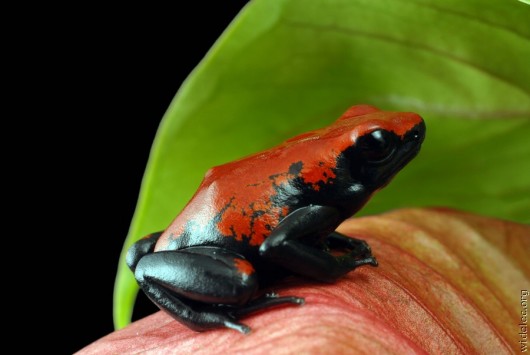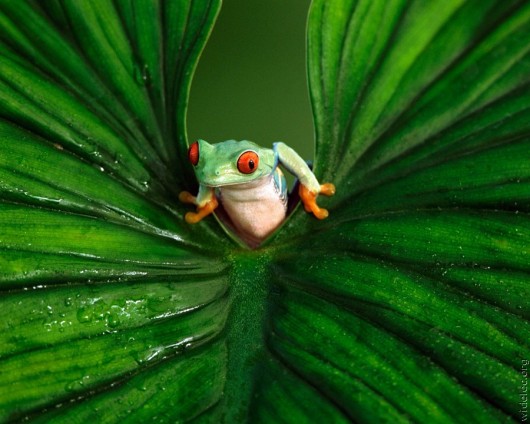Amphibian disease wiping out the world’s frogs
Wednesday, October 10th, 2012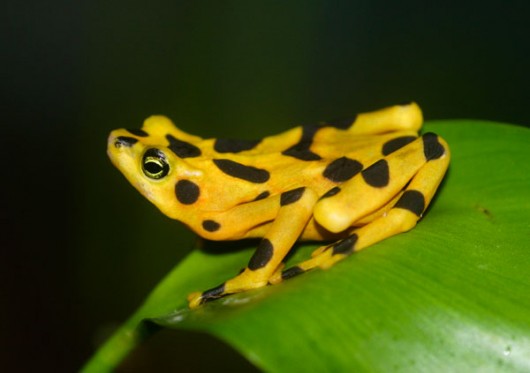 Panamanian Golden Frog
(Atelopus zeteki)
Now possibly Extinct in the Wild
(Photo by Brian Gratwicke, Smithsonian Conservation Biology Institute, Virginia, USA)
Panamanian Golden Frog
(Atelopus zeteki)
Now possibly Extinct in the Wild
(Photo by Brian Gratwicke, Smithsonian Conservation Biology Institute, Virginia, USA)
.
The Panamanian Golden Frog (Atelopus zeteki) is considered ‘Critically Endangered‘ by the International Union for Conservation of Nature (IUCN). Only three animals of this species have been seen in the wild since late 2007 and it is now quite possibly ‘Extinct in the Wild‘.
Fortunately for the species though, approximately 1,500 animals still exist aboard the AArk, thanks to the work of Project Golden Frog (www.ProjectGoldenFrog.org) and the El Valle Amphibian Conservation Center (EVACC) (www.houstonzoo.org/amphibians/) in central Panama.
The Amphibian Ark is currently trying to help create a dedicated facility in Panama, at the EVACC, to house an expanding population of golden frogs that will hopefully someday be used for reintroduction back into the wild.
[Source: ^http://frogmatters.wordpress.com/2010/02/27/help-save-the-panamanian-golden-frog/].
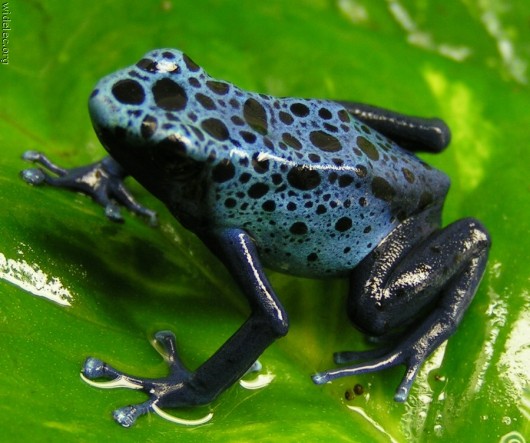 (Click image to enlarge)
(Click image to enlarge)
.
Chytridiomycosis Disease
.
‘Chytridiomycosis‘, a devastating amphibian disease, has spread to Panama’s Darien region, the last protected area in Central America. ‘Chytridiomycosis‘ is highly contagious across amphibians like frogs and is caused by a ‘chytrid fungus‘ (pronounced ‘kit-rid‘). The fungus is implicated in the decline or rapid extinction of at least 200 species of frogs and other amphibians worldwide, including twenty critically endangered frog species throughout Central America such as the Panamanian Golden Frog.
Smithsonian researchers found the disease in 2% of the 93 frogs tested. Yet the highly contagious disease has decimated numerous frog species worldwide, although some populations in Australia and the US appear to be making a comeback by evolving greater resistance. Within a span of five months, the fungus eradicated half of the frog species and 80% of individuals at the El Cope Nature Reserve in western Panama.
.
Nearly one-third of the world’s amphibians face extinction due to habitat loss, pollution and climate change with chytridiomycosis contributing to the extinction of 94 frog species since 1980.
.
The Panama Amphibian Rescue and Conservation Project has established captive colonies of two harlequin frog species endemic to Darien should they vanish from the wild.
[Source: ‘Fungus invades ‘frog paradise’ in Central America’, 14 June 2011, by Caitlin Stier, New Scientist (magazine) ^http://www.newscientist.com/blogs/shortsharpscience/2011/06/chytrid-fungus-spreads-to-last.html].
 ‘The Hidden Plague’
Mountain Yellow-legged Frog (Rana muscosa) corpses lie belly-up
(Photo by Joel Sartore)
Highly Commended photo in Environment Wildlife Photographer of the Year (2010)
Natural History Museum (London)
‘The Hidden Plague’
Mountain Yellow-legged Frog (Rana muscosa) corpses lie belly-up
(Photo by Joel Sartore)
Highly Commended photo in Environment Wildlife Photographer of the Year (2010)
Natural History Museum (London)
.
‘This is a crime scene in a remote corner of California, high in the Sixty Lakes Basin area of the Sierra Nevada: mountain yellow-legged frog corpses lie belly-up. The ‘chytridiomycosis‘ was first detected in dying frogs in the Sierra Nevada in 2004. It has since reduced the population of the Mountain Yellow-legged Frogs from tens of thousands to under a hundred.
The death of the frogs is emblematic of a global amphibian decline. It’s believed that the fungus is being spread in part by the international trade in amphibians for display, food and laboratory use, its effects enhanced by global warming.
.
Its impact on frogs has resulted in the biggest loss of vertebrate life due to disease ever recorded.
.
[Source: ‘2010 One Earth Award – Highly Commended’, Natural History Museum, ^http://www.nhm.ac.uk/visit-us/whats-on/temporary-exhibitions/wpy/prevPhoto.do?photo=2575&year=2010&category=52].
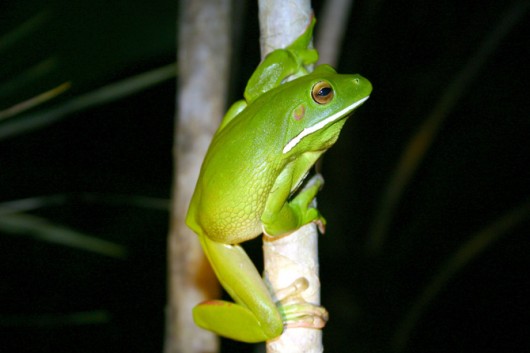 Green Tree Frog
(Litoria caerulea)
(Northern Tropical Australia)
[Source: ^http://www.portdouglas-australia.com/tour-green-tree-frog.html]
Green Tree Frog
(Litoria caerulea)
(Northern Tropical Australia)
[Source: ^http://www.portdouglas-australia.com/tour-green-tree-frog.html]
.
2003: Chytridiomycosis listed as a Key Threatening Process across Australia
.
In Australia, in 2003 Chytridiomycosis was acknowledged as a global epidemic impacting Australian frogs and amphibians and listed as a Key Threatening Process infecting and wiping out native frogs on Schedule 3 of the New South Wales (NSW) Threatened Species Conservation Act 1995 (22 August 2003).
The Chytridiomycosis disease is caused by the chytrid (fungus) ‘Batrachochytrium dendrobatidis‘ (Longcore et al. 1999), potentially fatal to all native species of amphibian.
As such, all frog species that are listed under the schedules of the Act may be affected by the disease. Fifty species of Australian frogs have been found infected with the chytrid fungus.
.
In NSW, 22 species, more than one quarter of the total NSW amphibian fauna, have been diagnosed with the disease.
.
High altitude (>400m) populations are more severely affected by Chytridiomycosis. Such population declines have been reported from the NSW uplands (Gillespie and Hines 1999, Hines et al. 1999). Stream-associated frog species are more likely to be infected because the pathogen is waterborne. The following are stream-breeding species of the NSW coast and ranges and may be threatened by chytridiomycosis (Gillespie and Hines 1999).
.
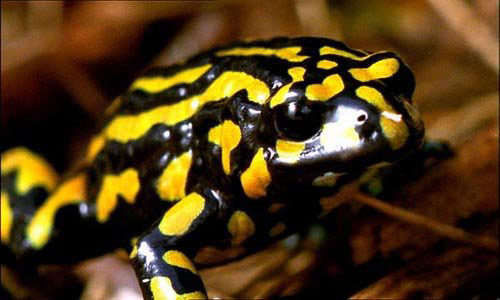 Southern Corroboree Frog
(Pseudophryne corroboree)
[Source: ^http://www.abc.net.au/science/scribblygum/june2004/closeup.htm]
Southern Corroboree Frog
(Pseudophryne corroboree)
[Source: ^http://www.abc.net.au/science/scribblygum/june2004/closeup.htm]
.
Chytridiomycosis has been reported from the following frog species and populations:
.
Endangered Frogs:
.
- Green and Golden Bell Frog
- Spotted Frog
- Fleay’s Barred Frog
- Giant Barred Frog
- Stuttering Barred Frog
- Booroolong Frog
- Southern Corroboree Frog
- Tusked Frog Population (Nandewar and New England Tablelands Bioregions)
.
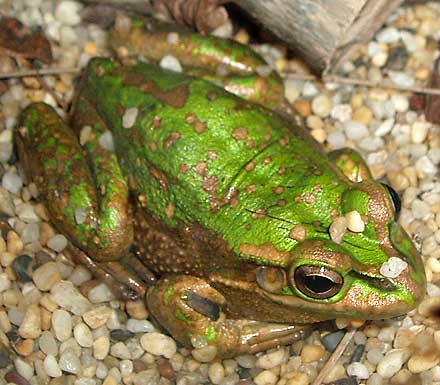 Green and Golden Bell Frog
(Litoria aurea)
[Source: ^http://www.saveourwaterwaysnow.com.au/01_cms/details.asp?ID=515]
Green and Golden Bell Frog
(Litoria aurea)
[Source: ^http://www.saveourwaterwaysnow.com.au/01_cms/details.asp?ID=515]
.
Vulnerable Frogs:
.
- Northern Corroboree Frog
- Giant Burrowing Frog
- Peppered Frog
- Glandular Frog
.
[Source: Australian Government, Department of Environment and Heritage, ^http://www.environment.nsw.gov.au/threatenedSpeciesApp/profile.aspx?id=20009].
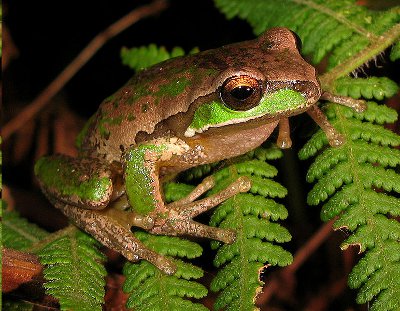 Glandular Frog (New England Tree Frog)
(Litoria subglandulosa)
[Source: ^http://www.ournaturalplanet.com/descriptions/amphibians/frogs.asp]
Glandular Frog (New England Tree Frog)
(Litoria subglandulosa)
[Source: ^http://www.ournaturalplanet.com/descriptions/amphibians/frogs.asp]
.
All amphibians are facing global extinction. It is that serious!
.
It is not just the world’s frogs that are at risk of extinction. All amphibian species are facing a current global extinction crisis of unprecedented magnitude.
The major factors causing their decline are the emerging disease Chytridiomycosis and Habitat Destruction.
Chytridiomycosis is caused by the aquatic fungus Batrachochytrium dendrobatidis and has been linked to species extinctions and population declines in montane regions including Australia, Panama, North America, and Spain. Currently, it is debated whether the recent emergence of the pathogen is largely the result of environmental factors triggering an outbreak of an endemic pathogen or if the epidemic has been caused by widespread introduction of the pathogen into naïve host populations (‘pathogen pollution‘).
We studied the population genetics of chytridiomycosis using DNA sequences from a global panel of strains. These data showed evidence of a strong genetic bottleneck in the history of the pathogen, and the epidemic appears traceable to the widespread dispersal of a single genotype. Populations were not structured by host-origin, and the same lineage was detected in populations of both resistant and highly sensitive species. The data suggest that the chytridiomycosis epidemic is caused by the emergence of a novel pathogen but that disease outcome is contingent on host resistance and environmental factors.
[Source: ‘Rapid Global Expansion of the Fungal Disease Chytridiomycosis into Declining and Healthy Amphibian Populations‘, by Timothy Y. James(1,2), Anastasia P. Litvintseva (3), Rytas Vilgalys (1), Jess A. T. Morgan (4), John W. Taylor (5), Matthew C. Fisher (6), Lee Berger (7), Ché Weldon (8), Louis du Preez (8), Joyce E. Longcore (9), ^http://www.plospathogens.org/article/info%3Adoi%2F10.1371%2Fjournal.ppat.1000458 –.
Academic References:
.- Department of Biology, Duke University, Durham, North Carolina, United States of America
- Department of Ecology and Evolutionary Biology, University of Michigan, Ann Arbor, Michigan, United States of America
- Department of Molecular Genetics and Microbiology, Duke University Medical Center, Durham, North Carolina, United States of America
- Department of Primary Industries & Fisheries, Animal Research Institute, Yeerongpilly, Queensland, Australia
- Department of Plant and Microbial Biology, University of California at Berkeley, Berkeley, California, United States of America
- Imperial College Faculty of Medicine, Department of Infectious Disease Epidemiology, St. Mary’s Campus, London, United Kingdom
- School of Public Health, Tropical Medicine and Rehabilitation Sciences, James Cook University, Townsville, Queensland, Australia
- School of Environmental Sciences and Development, North-West University, Potchefstroom, South Africa
- School of Biology & Ecology, University of Maine, Orono, Maine, United States of America]
.
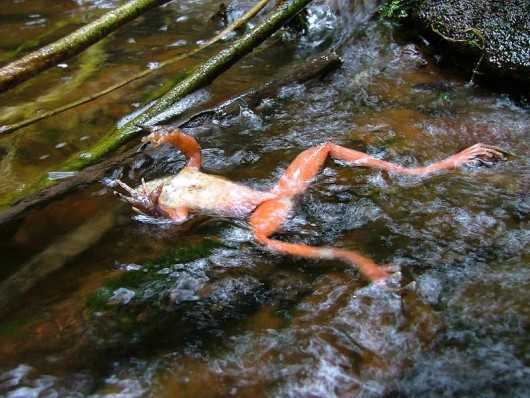 The Global Amphibian Crisis
[Source: ^http://johncarlosbaez.wordpress.com/2011/12/08/the-global-amphibian-crisis/]
The Global Amphibian Crisis
[Source: ^http://johncarlosbaez.wordpress.com/2011/12/08/the-global-amphibian-crisis/]
.
Frog Decline not just due to Disease
.
Upwards of 40% of amphibian species are in decline worldwide, owing to several factors:
.
- Habitat Loss
- Environmental Degradation
- Pollutants
- Disease
- Trade in Amphibians
.
The fungal pathogen Batrachochytrium dendrobatidis has emerged as a major threat to amphibians, which leads to the fatal chytridiomycosis in susceptible species.
The first documented outbreaks of chytrid fungus occurred in the late 1990s simultaneously in Australia and Central America. Since then the pathogen has been detected in over 100 amphibian species and has been associated with severe population declines or extinctions in several regions throughout the world. A great deal is still unknown about the biology of this pathogen, therefore it remains an active area of research for disease ecologists and conservation biologists.
.
.
Chytrid Fungus on Frogs:
.
B. dendrobatidis is an external pathogen that attaches to keratinized portions of amphibians, including the mouthparts of tadpoles and the skin of adults. The fungus reproduces via sporangia, and may be spread by movement of flagellated zoospores, direct contact between hosts, or between host stages. Growth of the fungus leads to degradation of the keratin layer, which eventually causes sloughing of skin, lethargy, weight loss, and potentially death. The physiological mechanism for chytrid-induced mortality is not known, but it appears to stem from disruption of skin function – such as fluid transport or gas exchange.
The chytrid fungus is known to infect over 100 species, but susceptibility to disease is highly life stage and species specific. For example, in mountain yellow legged frog (Rana muscosa) tadpoles suffer generally mild sublethal effects, with most mortality occurring at metamorphosis when there is a rapid production of newly keratinized skin tissue. Conversely, several other amphibian species appear to be relatively tolerant to B. dendrobatidis – including some widespread exotic or invasive species, such as the Marine Toad (Bufo marinus), American Bullfrog (Rana catesbeiana), and African Clawed Frog (Xenopus laevis).
.
 Chytridiomycosis infection cycle
[Source: ^http://theworldofrogs.weebly.com/chytrid-fungus.html]
Chytridiomycosis infection cycle
[Source: ^http://theworldofrogs.weebly.com/chytrid-fungus.html]
.
At the population level, chytrid fungus outbreaks have been associated with local and possible species extinctions in Australia, Central America, and the United States.
For example, in 2004 chytrid fungus prevalence in parts of Panama increased from zero to nearly 60% over approximately 4 months, with concomitant declines in amphibian density and diversity of over 80% and 60%, respectively. B. dendrobatidis is thought to thrive in cool, moist habitats. This has been used to argue that cooling trends observed in parts of Central America are driving chytrid-induced amphibian extinctions in these regions.
.
Distribution:
.
One explanation for the recent emergence of chytridiomycosis in amphibians, the “novel pathogen hypothesis”, is that B. dendrobatidis existed historically as a locally distributed pathogen that only recently was spread to new regions. Alternatively, the “endemic pathogen hypothesis” posits that the chytrid fungus was historically widespread but that recent environmental change (e.g., climate change, pollutants, habitat degradation) altered its pathogenicity. The relative importance of these two mechanisms is currently a source of debate. Low genetic diversity among geographically distant B. dendrobatidis strains is consistent with the first hypothesis, but synchronicity of chytrid fungus outbreaks in disparate, intact habitats supports the latter hypothesis.
The first described outbreaks of chytrid fungus occurred in 1998 in both Australia and Central America. Since then B. dendrobatidis infections have been documented throughout the Americas, including Mexico and the U.S., Europe, and most recently in Southeast Asia.
The oldest known chytrid fungus infections are from museum specimens of African clawed frogs (Xenopus laevis) collected in 1938. These specimens have been used to argue for an African origin for B. dendrobatidis.
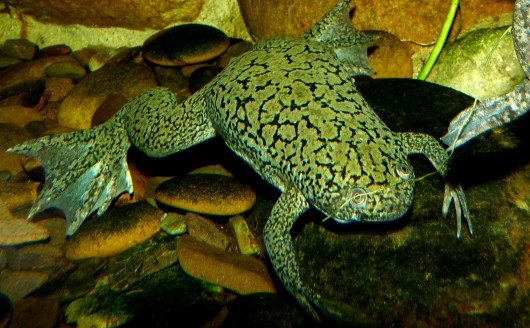 African Clawed Frog
(Xenopus laevis)
[Source: ^http://www.sacredheartofodin.org/tag/african-clawed-frog/]
African Clawed Frog
(Xenopus laevis)
[Source: ^http://www.sacredheartofodin.org/tag/african-clawed-frog/]
.
It is believed that the chytrid was then spread to other continents in the 1960s and 70s through commercial trade of these African frogs. (Ed: i.e. poaching)
.
Research:
.
The link between chytridiomycosis and amphibian decline is an active area of research worldwide. The genome of B. dendrobatidis has been sequenced, which should prove useful for identifying the origin, mechanisms of virulence, and potential control methods for this pathogen. University of California researchers have been studying this pathogen for several years, especially the impacts of chytrid fungus on populations of the mountain yellow legged frog (Rana muscosa) in the Sierra Nevada Mountains in California.
This once abundant alpine frog has undergone severe declines in recent years, with numerous local die-offs. Research is being conducted on the spatial epidemiology of disease in R. muscosa, to understand why some local populations persist whereas others go extinct. Projects include identifying the modes of pathogen spread, impacts of outbreaks on alpine food webs, and the population genetic consequences of outbreaks for frogs.
With regard to frog population and disease management, experiments include evaluating the efficacy of anti-fungal treatments and the feasibility of reintroducing frogs into previous outbreak areas.
.
[Source: ‘Chytrid Fungus (Batrachochytrium dendrobatidis)’, Center for Invasive Species Research, University of California, Riverside, USA, ^http://cisr.ucr.edu/chytrid_fungus.html].
.
Chytrid fungus killing off Tasmanian Frogs
.
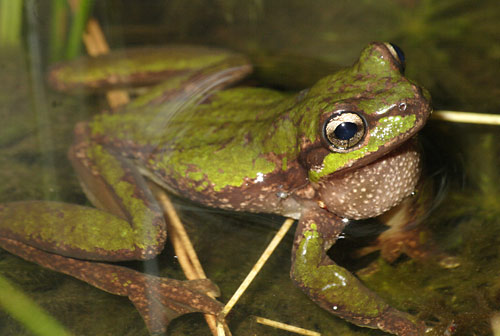 Healthy Tasmanian Tree Frog
(Litoria burrowsae – endemic to Western Tasmania)
(Photo by Iain Stych)
Healthy Tasmanian Tree Frog
(Litoria burrowsae – endemic to Western Tasmania)
(Photo by Iain Stych)
.
What is chytrid fungus?
.
‘Batrachochytrium dendrobatidis‘ causes the disease known as chytridiomycosis or chytrid infection which currently threatens Tasmania’s native amphibians.
The fungus infects the skin of frogs destroying its structure and function, and can ultimately cause death. Sporadic deaths occur in some frog populations, and 100 per cent mortality occurs in other populations.
Chytrid infection has been devastating to frog species causing extinctions worldwide. The international trade of frogs probably brought the fungus to Australia from Africa. The disease has now been recorded in four regions in Australia – the east coast, southwest Western Australia, Adelaide, and more recently Tasmania. In mainland Australia chytrid has caused the extinction of one frog species, and has been associated with the extinction of three other species. In addition, the threatened species status of others frogs has worsened through severe declines in numbers.
.
What is the threat to Tasmanian frogs?
.
Tasmania supports 11 frog species with three of these species, the Tasmanian Tree Frog, the Tasmanian Froglet and the Moss Froglet, found nowhere else in the world. These precious species are at risk from the disease. In addition, two other frog species, the Green and Golden Frog and the Striped Marsh Frog, are already threatened in Tasmania. Chytrid infection has the potential to devastate these, and other frog populations.
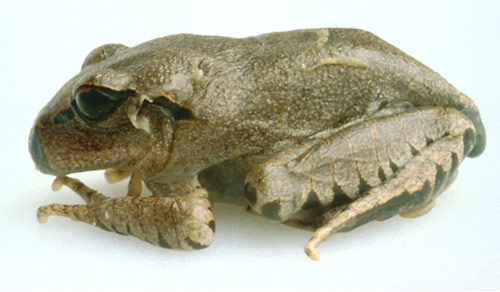 Chytrid-infected Queensland Great Barred Frog
(Mixophyes fasciolatus)
(Photo Lee Berger)
Chytrid-infected Queensland Great Barred Frog
(Mixophyes fasciolatus)
(Photo Lee Berger)
.
What does an infected frog look like?
- Abnormal posture and behaviour. Frogs may sit with their hind legs out, wobble or show difficulty moving or fleeing, or may even have a seizure.
- Skin changes. The skin may be discoloured, peel, or possibly ulcerated. The body may swell.
- Sudden death.
- Tadpoles may demonstrate abnormal mouthparts. These abnormalities are difficult to detect and require expertise.
.
How is it spread?
.
The movement of infected frogs, tadpoles and water are the known key agents of spread. The fungus (or infected frogs or tadpoles) can be spread by people in water and mud on boots, camping equipment and vehicle tyres, and in water used for drinking, or spraying on gravel roads or fighting fires.
.
Where is chytrid in Tasmania?
.
In Tasmania, chytrid infection has spread widely in habitats associated with human disturbance and will continue to spread unless we act quickly. Once established, it is extremely difficult to eradicate chytrid fungus from the natural environment.
.
Remote areas in Tasmania, particularly the Tasmanian Wilderness World Heritage Area, are still largely free of disease and it is our challenge to keep it out.
.
What is being done?
.
The distribution of chytrid fungus in Tasmania has been mapped by DPIPWE and the Central North Field Naturalists. Ongoing monitoring of important areas is being conducted by DPIPWE. Our increasing knowledge of this important disease is crucial if we are to effectively reduce fungal spread to uninfected frog habitat.
The National Chytrid Threat Abatement PlanYou are now leaving our site. DPIPWE is not responsible for the content of the web site to which you are going. The link does not constitute any form of endorsement aims to prevent further spread of chytrid fungus in Australia, and to decrease the impact of the fungus on currently infected populations.
DPIPWE supports the national threat abatement plan in the recently produced strategy for managing wildlife disease in the Tasmanian Wilderness World Heritage Area. Chytrid fungal disease is the top priority in the Strategy and a number of management actions are being undertaken. In addition, the Wildlife Health in Tasmania Manual describes chytrid infection in more detail.
Land management agencies are reviewing their practices to determine activities that have potential to spread chytrid fungus and ways to minimise the spread.
.
Is there any effective treatment?
.
To date there is no effective way to effectively treat wild infected frog populations. The main aim of management is to prevent further spread of chytrid fungus from infected to uninfected sites. Chytrid fungus is killed by effective cleaning and drying. In addition, a number of disinfectants are effective.
.
What to consider when collecting and reporting tadpoles and frogs?
.
- If it is necessary to collect tadpoles or frogs, always return them to the collection site. Contact DPIPWE for information relating to frog collection and permits. Never move frogs or tadpoles to new locations.
- Remember it is an offence to take or disturb frogs and tadpoles in Tasmania’s national parks and other reserves without a permit. It is also an offence to bring frogs or tadpoles into reserves.
- Never release frogs found in imported fresh produce (usually banana boxes) and nursery products. Report non-Tasmanian frogs for collection to Wildlife Enquiries, DPIPWE.
- Report sightings of sick or dead frogs to Wildlife Enquiries, DPIPWE.
.
What you can do to stop the spread of chytrid?
.
- Keep your gear clean – clean boots and camping equipment of soil and allow to dry completely before visiting remote areas.
- Plan to wash and dry vehicles (including tyres) and equipment before entering dirt roads within areas that are reserved or largely free of human disturbance.
- Think about water disposal – when disposing of small or large volumes of water within a natural environment, ensure you are as far as possible from creeks, rivers, ponds and lakes. A dry stony disposal site is far preferable to a moist muddy one.
- Avoid transferring aquatic plants, water, soils and animals between frog habitats (for example, nursery plants, wet land fill and fish).
- Hygiene protocols for biologists and field workers visiting freshwater environments are outlined at the James Cook University web site on amphibian diseasesYou are now leaving our site. DPIPWE is not responsible for the content of the web site to which you are going. The link does not constitute any form of endorsement.
- Education in relation to disease management is critical if we are to stop the spread of this important disease. Spread the word!’
.
[Ed: This is why we wrote this article, but also, when we attended a photographic exhibition of The Environment Wildlife Photographer of the Year (2010) and saw Joel Sartore’s photo ‘The Hidden Plague’, it disturbed us]
 .
.
.
2012: Disease is getting worse – it’s now killing off previously tolerant species
.
‘There is no point sending healthy animals out into the world if they’re just going to catch a deadly disease.
Pacific tree frogs that can survive a normally lethal fungus infection are spreading it to species that cannot. Such “reservoir” species could threaten frogs released from captive breeding programmes.
Between 2003 and 2010, the deadly chytrid fungus slashed the populations of two frog species in the Sierra Nevada, while populations of a third species – the Pacific tree frog (Pseudacris regilla) – held steady. That isn’t because the Pacific tree frogs avoided infection: two-thirds of the Sierra Nevada population carry the fungus, Vance Vredenburg of San Francisco State University has now found. That suggests they can tolerate infection and so could spread the pathogen to new areas.
Conservationists are breeding threatened amphibians in captivity in the hope of eventually re-establishing them in the wild. But reintroductions will fail if there is a reservoir species nearby, Vredenburg warns.
The solution may be to breed from frog populations already decimated by the chytrid fungus, says Matthew Fisher of Imperial College London. There is evidence that some frogs are evolving tolerance, and survivors from an affected population are more likely to have the vital genes. These frogs could be cross-bred with susceptible individuals, accelerating the spread of tolerance – although Fisher admits the approach will be expensive.’
[Source: ‘Deadly frog disease spreads through tolerant species’, 20120313, by Michael Marshall, New Scientist (magazine issue 2856), ^http://www.newscientist.com/article/dn21583-deadly-frog-disease-spreads-through-tolerant-species.html].
.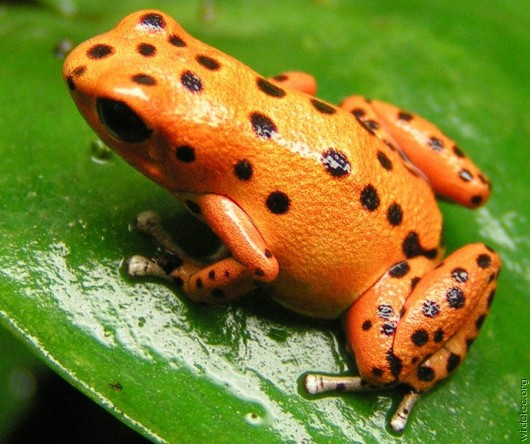 (Click image to enlarge)
(Click image to enlarge)
.
Further Reading:
.
[1] Queensland Frog Society, Australia, ^http://www.qldfrogs.asn.au/.
[2] Frog Disease, Frogs Australia Network, Australia, ^http://www.frogsaustralia.net.au/conservation/disease.cfm.
[3] Amphibian Diseases, James Cook University, Australia, ^http://www.jcu.edu.au/school/phtm/PHTM/frogs/ampdis.htm.
[4] Batrachochytrium dendrobatidis Project, Herpetofauna Foundation, Holland, ^http://www.stichtingherpetofauna.com/uk/projecten/batrachochytrium_dendrobatidis.html.
[5] Boreal Toad Conservation, Colorada Parks and Wildlife, United States, ^http://wildlife.state.co.us/Research/Aquatic/BorealToad/Pages/BorealToad.aspx.
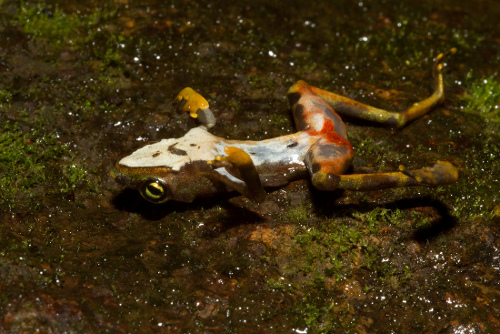 Limosa Harlequin Frog
(Atelopus limosus)
…endemic to Panama, this frog has died from Chytridiomycosis.
Notice the reddening of the skin and the lesions on its belly.
[Source: ‘Frog-killing fungus is a skin-loving hybrid’, 20111123, by Lucas Brouwers, Scientific American,
^http://blogs.scientificamerican.com/thoughtomics/2011/11/23/frog-killing-fungus-is-a-skin-loving-hybrid-killer/]
Limosa Harlequin Frog
(Atelopus limosus)
…endemic to Panama, this frog has died from Chytridiomycosis.
Notice the reddening of the skin and the lesions on its belly.
[Source: ‘Frog-killing fungus is a skin-loving hybrid’, 20111123, by Lucas Brouwers, Scientific American,
^http://blogs.scientificamerican.com/thoughtomics/2011/11/23/frog-killing-fungus-is-a-skin-loving-hybrid-killer/]
